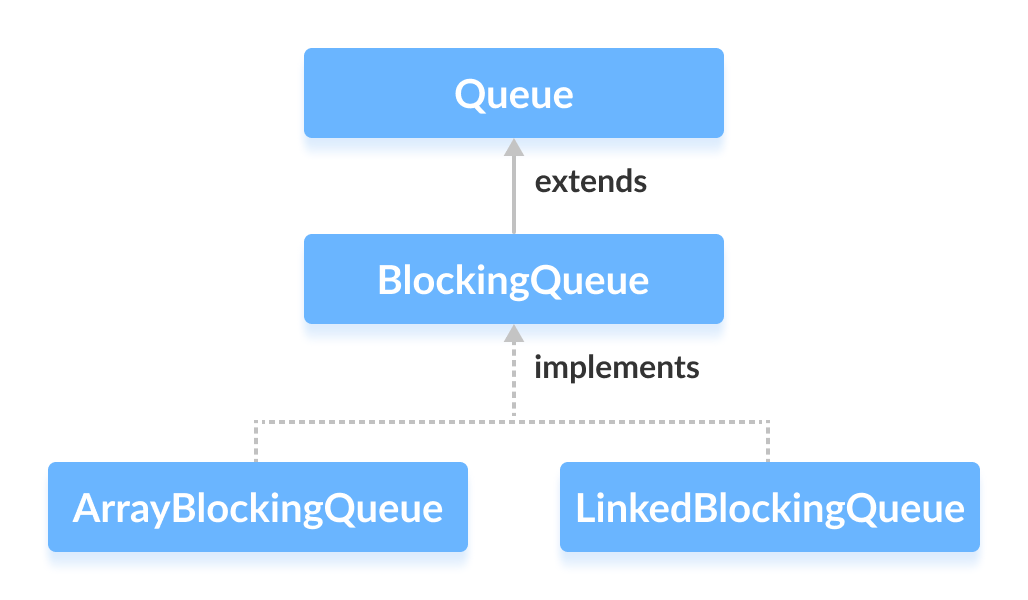(Java programming Example for Beginners)
Java BlockingQueue
In this tutorial, we will learn about the Java BlockingQueue interface and its methods.
BlockingQueue interface of the Java Collections framework extends the Queue interface. It allows any operation to wait until it can be successfully performed.For example, if we want to delete an element from an empty queue, then the blocking queue allows the delete operation to wait until the queue contains some elements to be deleted.
Classes that Implement BlockingQueue
Since BlockingQueue is an interface, we cannot provide the direct implementation of it.
In order to use the functionality of the BlockingQueue, we need to use classes that implement it.
- ArrayBlockingQueue
- LinkedBlockingQueue

How to use blocking queues?
We must import the java.util.concurrent.BlockingQueue package in order to use BlockingQueue.
// Array implementation of BlockingQueue
BlockingQueue<String> animal1 = new ArraryBlockingQueue<>();
// LinkedList implementation of BlockingQueue
BlockingQueue<String> animal2 = new LinkedBlockingQueue<>();
Here, we have created objects animal1 and animal2 of classes ArrayBlockingQueue and LinkedBlockingQueue, respectively. These objects can use the functionalities of the BlockingQueue interface.
Methods of BlockingQueue
Based on whether a queue is full or empty, methods of a blocking queue can be divided into 3 categories:
Methods that throw an exception
add()– Inserts an element to the blocking queue at the end of the queue. Throws an exception if the queue is full.element()– Returns the head of the blocking queue. Throws an exception if the queue is empty.remove()– Removes an element from the blocking queue. Throws an exception if the queue is empty.
Methods that return some value
offer()– Inserts the specified element to the blocking queue at the end of the queue. Returnsfalseif the queue is full.peek()– Returns the head of the blocking queue. Returnsnullif the queue is empty.poll()– Removes an element from the blocking queue. Returnsnullif the queue is empty.
More on offer() and poll()
The offer() and poll() method can be used with timeouts. That is, we can pass time units as a parameter. For example,
offer(value, 100, milliseconds)
Here,
- value is the element to be inserted to the queue
- And we have set a timeout of 100 milliseconds
This means the offer() method will try to insert an element to the blocking queue for 100 milliseconds. If the element cannot be inserted in 100 milliseconds, the method returns false.
Note: Instead of milliseconds, we can also use these time units: days, hours, minutes, seconds, microseconds and nanoseconds in offer() and poll() methods.
Methods that blocks the operation
The BlockingQueue also provides methods to block the operations and wait if the queue is full or empty.
put()– Inserts an element to the blocking queue. If the queue is full, it will wait until the queue has space to insert an element.take()– Removes and returns an element from the blocking queue. If the queue is empty, it will wait until the queue has elements to be deleted.
Suppose, we want to insert elements into a queue. If the queue is full then the put() method will wait until the queue has space to insert elements.
Similarly, if we want to delete elements from a queue. If the queue is empty then the take() method will wait until the queue contains elements to be deleted.
Implementation of BlockingQueue in ArrayBlockingQueue
import java.util.concurrent.BlockingQueue;
import java.util.concurrent.ArrayBlockingQueue;
class Main{
public static void main(String[] args){
// Create a blocking queue using the ArrayBlockingQueue
BlockingQueue<Integer> numbers = new ArrayBlockingQueue<>(5);
try {
// Insert element to blocking queue
numbers.put(2);
numbers.put(1);
numbers.put(3);
System.out.println("BLockingQueue: " + numbers);
// Remove Elements from blocking queue
int removedNumber = numbers.take();
System.out.println("Removed Number: " + removedNumber);
}
catch(Exception e) {
e.getStackTrace();
}
}
}
Output
BlockingQueue: [2, 1, 3] Removed Element: 2
Why BlockingQueue?
In Java, BlockingQueue is considered as the thread-safe collection. It is because it can be helpful in multi-threading operations.
Suppose one thread is inserting elements to the queue and another thread is removing elements from the queue.
Now, if the first thread runs slower, then the blocking queue can make the second thread wait until the first thread completes its operation.
Java tutorials for Beginners – Java BlockingQueue
Two Machine Learning Fields
There are two sides to machine learning:
- Practical Machine Learning:This is about querying databases, cleaning data, writing scripts to transform data and gluing algorithm and libraries together and writing custom code to squeeze reliable answers from data to satisfy difficult and ill defined questions. It’s the mess of reality.
- Theoretical Machine Learning: This is about math and abstraction and idealized scenarios and limits and beauty and informing what is possible. It is a whole lot neater and cleaner and removed from the mess of reality.
Disclaimer: The information and code presented within this recipe/tutorial is only for educational and coaching purposes for beginners and developers. Anyone can practice and apply the recipe/tutorial presented here, but the reader is taking full responsibility for his/her actions. The author (content curator) of this recipe (code / program) has made every effort to ensure the accuracy of the information was correct at time of publication. The author (content curator) does not assume and hereby disclaims any liability to any party for any loss, damage, or disruption caused by errors or omissions, whether such errors or omissions result from accident, negligence, or any other cause. The information presented here could also be found in public knowledge domains.

